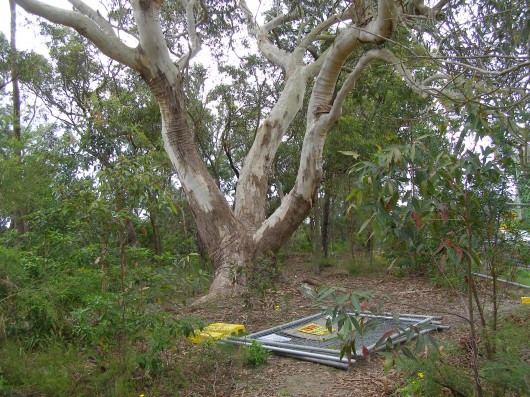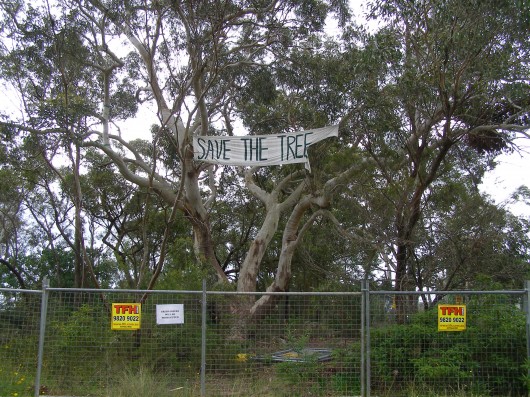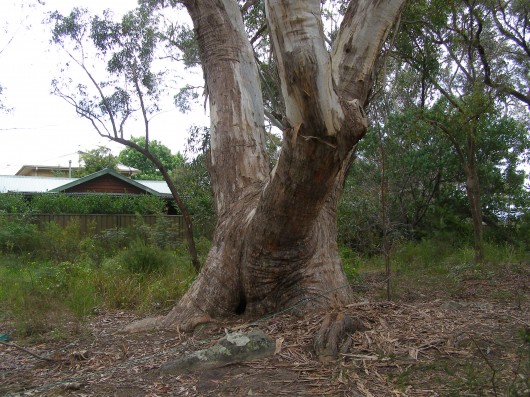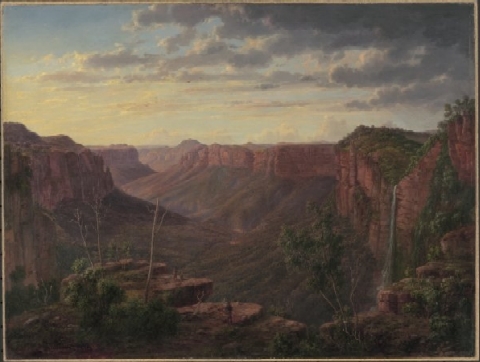Blue Mountains: Faulconbridge native cleansing
Monday, December 26th, 2011 A native Scribbly Gum of Faulconbridge, Blue Mountains, Australia
…perhaps over 200 years old, healthy and in its natural setting.
(Photo by Editor 20111226, free in public domain, click photo to enlarge)
A native Scribbly Gum of Faulconbridge, Blue Mountains, Australia
…perhaps over 200 years old, healthy and in its natural setting.
(Photo by Editor 20111226, free in public domain, click photo to enlarge)
.
. …but simply because land developers want to destroy the bush for selfish housing, they legally claim the tree is ‘potentially dangerous’
It seems the New South Wales Court Commissioner has sympathised and condemned the tree to a chainsaw death.
(Photo by Editor 20111226, free in public domain, click photo to enlarge)
…but simply because land developers want to destroy the bush for selfish housing, they legally claim the tree is ‘potentially dangerous’
It seems the New South Wales Court Commissioner has sympathised and condemned the tree to a chainsaw death.
(Photo by Editor 20111226, free in public domain, click photo to enlarge)
.
Court Presumptuous?
.
The New South Wales Land (before) Environment Court has demonised and stigmatised this native Eucalypt tree as a “hybrid” (i.e. as a ‘half cast’ in human terms). The Acting Commissioner has ruled a death warrant upon this native old growth Eucalypt in its natural bushland setting on the following three bases:
..
Basis #1. Blue Mountains ‘Significant Tree’ protection ignores claims of a tree being somehow dangerous (however contrived, false and self-servingly malicious the rationale)
.
“While the provisions of (Blue Mountains Council’s) Development Control Plan (DCP) 9 must be considered as a fundamental element in the decision process…it does not necessarily follow that the tree should be retained under any circumstances.
“DCP 9 is silent on how to address trees that are potentially dangerous or unhealthy although Clause 6 provides the opportunity to “cut down”… any tree on the Register of Significant Trees” but with the consent of Council.”
(Ed: Blue Mountains Council had unanimously rejected the development application – so the ‘acting’ Commissioner is presuming any real opportunity and by raising such weak argument is siding with the developer).
.
Basis #2. The ‘acting’ Commissioner rejects the tree’s scenic quality instantly without due consideration and with a presumed fear of trees
.
“Accepting that the Hybrid adds to the scenic quality of the site and the surrounding area, this benefit needs to be balanced against the likely longevity of the tree and its health. (Ed: The Court has no grounds for estimating the longevity of this tree, and seems to be surmising on the basis of personal prejudice).
In this case, I have little trouble in concluding that the balance falls in favour of the removal of the tree . The conclusions of the two tomograph (xray) tests and the evidence of Dr McDonald and Mr James, and supported by the council officer, leave little doubt as to the appropriate outcome.
(Ed: Tomograph tests and evidence withheld in Court decision, so how do we know the tree is unhealthy?)
“I do not accept that the retention of the tree, irrespective of the scenic quality links to the area, should be preferred when there is a serious and legitimate question over the safety of the tree. (Ed: The “serious and legitimate question over the safety of the tree” is unsubstantiated and appears presumptive).
“In my view, the overwhelming expert and scientific evidence clearly suggests that the tree is dangerous and presents an unsafe situation for future ocupants of the site.”
(Ed: ‘Overwhelming‘ from what independent qualified and scientifically relevant source and where is the report? The ‘acting‘ Commissioner’s presumption of ‘future occupants of the site‘ suggests a high probability of judicial bias).
.
Basis #3. Tree canopies are inconsistent with housing safety
.
“Even if a dwelling is constructed outside of the area covered by the tree canopy, I am not satisfied that (it) sufficiently overcomes the potential danger from the tree. It would be clearly impractical to fence off the area under the canopy, given the limited area remaining for a dwelling on the site and the need to provide ancillary matters such as private open space and building setbacks.” (Ed: The Court is prejudging that the developer proposal for dwellings (x2) and proposed private open space and building setbacks have precedent values over the natural values of pre-existicng native bushland including a Council-protected significant mature native tree, native vegetation and bushrock).
“The suggestion by Ms Hobley that a dwelling could be located underneath the (tree) canopy is misconceived, given the weight of evidence for branch failure and which is supported by the obvious example where an existing branch has failed and only remains because it is held up by another tree on the site. I am not satisfied that Ms Hobley has given proper consideration to the potential for injury in her assessment of the tree.”
.
(Ed: The ‘acting’ Commissioner conveys an preconceived view that trees are dangerous. Details of “an existing branch” failing are not available in the Court’s decision.)
.
 A native Eucalypt, condemned as a ‘hybrid’
by those who themselves are but hybrid descendants of colonists
because human invasion is enshrined in law as having a superior value than existing native old growth.
(Photo by Editor 20111226, free in public domain, click photo to enlarge)
A native Eucalypt, condemned as a ‘hybrid’
by those who themselves are but hybrid descendants of colonists
because human invasion is enshrined in law as having a superior value than existing native old growth.
(Photo by Editor 20111226, free in public domain, click photo to enlarge)
.
The Habitat Advocate is pleased to support the efforts of local people in Faulconbridge trying to save this grand native tree from being killed. For further information visit: ^http://savethetree.org/
.
.
‘Native Cleansing’
.
Clearing native trees for human development is a value judgment of convenience. Philosophically native tree cleansing is no different to ethic cleansing of one human ethic group of another.
 Native forest deforestation (ethnic cleansing)
– at record levels across New South Wales
Native forest deforestation (ethnic cleansing)
– at record levels across New South Wales
.
‘Ethnic Cleansing’ is a process in which advancing army of one ethnic group expels civilians of other ethnic groups from towns and villages it conquers in order to create ethnically pure enclaves for members of their ethnic group.
‘Serbian military commander in Bosnia, a war criminal sought by the War Crimes Tribunal in The Hague, Ratko Mladic, sometimes issued specific orders to his subordinates to shell a particular village more than others, because there is less Serbs and more Muslims living there. Often, refugees of one ethnic group previously “cleansed” from their homes by other ethnic group are made to live in freshly “cleansed” territory of that other ethnic group.’
.
[Source: ^http://balkansnet.org/ethnicl.html].
 In 2011 humanity continues to trash the sublime for a selfish vista
In 2011 humanity continues to trash the sublime for a selfish vista
.
.
.
Further Reading:
.
[1] ^http://treeshaverightstoo.com/
‘It’s not just humans who have rights, all beings do. The right not to be polluted is a right that belongs to us as well as to the Earth, to the air we breathe and to future generations. There are other rights which apply to us all, the problem is that they are not yet recognised internationally. But this is rapidly changing and you can find more information about the campaigns and progress of this fast developing arena of humanitarian and environmental law, called Earth Law.’
.
[3] ‘Should Trees Have Standing? – Toward Legal Rights for Natural Objects’, by Christopher Stone, ^http://isites.harvard.edu/fs/docs/icb.topic498371.files/Stone.Trees_Standing.pdf [Read Article]
.
[2] ^http://therightsfuture.com/t16-do-trees-have-rights/
.
[3] ^http://northshorewoman.blogspot.com/2011/12/trees-have-rights-too.html







